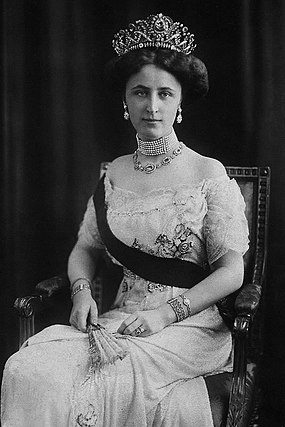by Susan Flantzer
© Unofficial Royalty 2017

Princess Anne and Timothy Laurence on their wedding day; Credit – www.dailymail.co.uk
Princess Anne married Timothy Laurence on December 12, 1992, at Crathie Kirk in Crathie, Scotland near Balmoral Castle.
Princess Anne’s Early Life
Anne Elizabeth Alice Louise was born at Clarence House in London, England on August 15, 1950. She was the second child of the four children and the only daughter of Queen Elizabeth II of the United Kingdom and Prince Philip, Duke of Edinburgh (born a Prince of Greece and Denmark). Anne had one elder brother Charles and two younger brothers, Andrew and Edward.
At the time of Anne’s birth, her mother was Princess Elizabeth, Duchess of Edinburgh and the sovereign was her grandfather, King George VI. The children of a daughter of a British sovereign would not usually have been accorded the style Royal Highness or the titles Prince/Princess as in the case of Anne’s own children. However, on October 22, 1948, Anne’s grandfather King George VI issued letters patent allowing the children of his eldest daughter and heiress presumptive, to use the style and title of a royal prince or princess. Therefore, Anne was Her Royal Highness Princess Anne of Edinburgh at birth.
King George VI died on February 6, 1952, and his elder daughter Princess Elizabeth became Queen. Upon her mother’s accession to the throne, Anne was styled Her Royal Highness The Princess Anne. Anne was too young to attend her mother’s coronation, but she did make an appearance on the balcony of Buckingham Palace as seen in the above photo.
Catherine Peebles, the governess of Prince Charles was also Anne’s governess and was responsible for Anne’s early education. In 1959, a Girl Guides company, 1st Buckingham Palace Company was formed at the palace to allow Anne to socialize with other girls. Similar Girl Guide companies had been formed at Buckingham Palace for Anne’s mother and her aunt Princess Margaret. From 1963-1968, Anne attended Benenden School, an independent boarding school for girls in Kent, England.
From a young age, Princess Anne was passionate about riding and soon became an excellent equestrienne. In 1971, Anne won the European Eventing Championship and was voted the BBC Sports Personality of the Year. For more than five years Anne competed with the British eventing team, winning a silver medal in both individual and team disciplines in the 1975 European Eventing Championship. In the 1976 Montreal Summer Olympics, Anne competed as a member of the British equestrian team.
Princess Anne married Captain Mark Phillips, a fellow equestrian, on November 14, 1973, at Westminster Abbey in London, England. The couple had two children: Peter (born 1977) and Zara (born 1981). Anne and her first husband separated in 1989 and their divorce was finalized on April 23, 1992.
For more information, see Unofficial Royalty: Princess Anne, The Princess Royal
Timothy Laurence’s Early Life
Timothy James Hamilton Laurence was born on March 1, 1955, in Camberwell, South London, England, the son of Guy Laurence and Barbara Symonds. His father was a Commander in the Royal Navy and then a salesman for a marine engine manufacturer. Timothy grew up in Kent, England along with his older brother Jonathan.
Timothy began his education at The New Beacon Preparatory School in Sevenoaks, Kent, England. He then attended Sevenoaks School also in Sevenoaks, Kent, England, founded in 1432. Timothy attended University College, Durham on a Naval Scholarship where he was the editor of the student newspaper and captain of the cricket team. He graduated with a Bachelors degree in geography and then completed his naval training at the Britannia Royal Naval College Dartmouth.
Timothy served on several Royal Navy ships as a navigating officer and then as a commander. From 1986-1989, he had his first staff appointment as Equerry to Queen Elizabeth II. An equerry must be a senior officer in the British Armed Services. Timothy also served in various posts in the Ministry of Defence. He retired from the Royal Navy in 2010 with the rank of Vice Admiral.
For more information, see Unofficial Royalty: Vice Admiral Sir Timothy Laurence
The Couple
Embed from Getty Images
Timothy Laurence smiling at Princess Anne at the 1989 Royal Ascot Races. Anne is in the white outfit. The little girl is Anne’s daughter Zara.
Timothy first met his future wife, Anne, Princess Royal when he was Equerry to Queen Elizabeth II. As the Queen’s Equerry for three years, Timothy learned the ways of the Royal Family. He often ate with the family, accompanied them on outings, cruised with them on the royal yacht, and made the formal introductions when important guests visited. Anne’s marriage to Mark Phillips was in trouble and Timothy caught her eye. However, it was not until 1989, when four of Timothy’s love letters were stolen from Anne’s briefcase at Buckingham Palace that the romance came to light. In the same year, Anne separated from her first husband, but the courtship with Timothy remained discreet. The couple was seldom seen together until Anne’s divorce became final in April 1992.
The couple’s intention to marry was announced by Buckingham Palace on December 5, 1992, just a week before the wedding. A Palace spokesperson said, “Due to the level of speculation about the matter, we decided to confirm that The Princess Royal and Commander Laurence are planning to marry, but I cannot say where and when.”
Timothy gave Anne a ring with a cabochon sapphire surrounded by three small diamonds on either side.
The Wedding

Photo Credit – http://www.hellomagazine.com
The small, private wedding was held on December 12, 1992, at the tiny Crathie Kirk in Crathie, Scotland where the British Royal Family worships when they are at Balmoral Castle. The couple chose to marry in Scotland as the Church of England did not at that time allow divorced persons whose former spouses were still living to remarry in its churches. The Church of Scotland does not consider marriage to be a sacrament and has no objection to the remarriage of divorced persons.
Princess Anne arrived at Crathie Kirk accompanied by her father Prince Philip and her 11-year-old daughter Zara who acted as her bridesmaid. Anne was dressed in a simple white suit with white blossoms in her hair and Timothy was wearing his Royal Navy uniform. Before about 30 guests, the bride and groom exchanged vows to stay together “until God shall separate us by death.” After the ceremony, the newlyweds emerged from the church to the cheers of about 500 well-wishers. Press and photographers were barred from the church but they lined the road from Balmoral Castle to Crathie Kirk.
Among the guests were Queen Elizabeth II, Prince Philip, The Queen Mother, Princess Margaret, Anne’s three brothers: Prince Charles, Prince Andrew, and Prince Edward, and Anne’s two children Peter Phillips and Zara Phillips. Two prominent members of the Royal Family were absent: The Princess of Wales, whose formal separation from her husband had been announced a few days earlier, and The Duchess of York who was separated from her husband Prince Andrew. The Princess of Wales sent her best wishes to Anne. Aides indicated she did not attend because she did not want Anne’s wedding to become a media circus.
After the wedding, the newlyweds and their guests had a short celebration at Craigowan Lodge on the Balmoral Estate.
This article is the intellectual property of Unofficial Royalty and is NOT TO BE COPIED, EDITED, OR POSTED IN ANY FORM ON ANOTHER WEBSITE under any circumstances. It is permissible to use a link that directs to Unofficial Royalty.
Works Cited
- latimes. (2017). Britain’s Princess Anne Remarries: Wedding: Scottish ceremony brings a tiny bit of joy to a year that saw more than one royal marriage fail.. [online] Available at: http://articles.latimes.com/1992-12-13/news/mn-4165_1_princess-anne [Accessed 31 Aug. 2017].
- Nytimes.com. (2017). In Quiet Scottish Ceremony, Anne Marries Naval Officer. [online] Available at: http://www.nytimes.com/1992/12/13/world/in-quiet-scottish-ceremony-anne-marries-naval-officer.html?mcubz=3 [Accessed 31 Aug. 2017].
- Unofficial Royalty. (2017). Anne, Princess Royal. [online] Available at: https://www.unofficialroyalty.com/anne-the-princess-royal/ [Accessed 26 Aug. 2017].
- Unofficial Royalty. (2017). Vice Admiral Sir Timothy Laurence. [online] Available at: https://www.unofficialroyalty.com/timothy-laurence-husband-of-anne-the-princess-royal/ [Accessed 31 Aug. 2017].
- UPI. (2017). Princess Anne to marry former royal attendant. [online] Available at: https://www.upi.com/Archives/1992/12/05/Princess-Anne-to-marry-former-royal-attendant/4441723531600/ [Accessed 31 Aug. 2017].





























